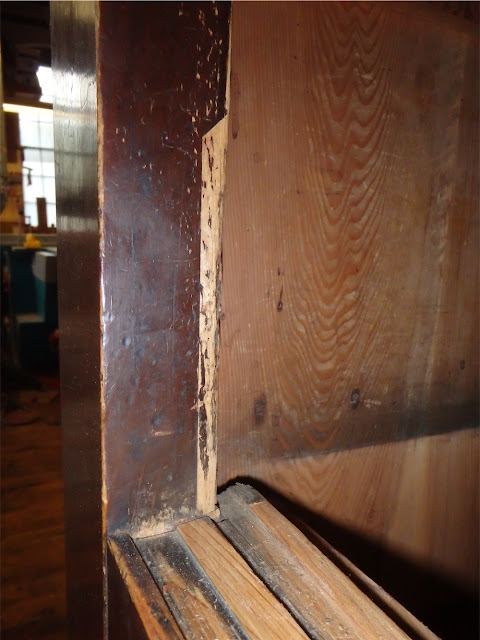Working now on the upper section (cabinet) of the mizuya-dansu:
My main task on this cabinet is to repair the sliding doors and track on the large compartment. However, issues abounded in other areas. For example, all of the openings for the lower bank of drawers were damaged on each side, as if by the action of the lower edge of the drawer sides:
I’ll be repairing these gouges, probably by removing the lower rail, if possible, and rebuilding it.
These drawers do not have conventional sides with floor boards carried in a dado, rather the floor panel is simply nailed to the bottom, so the drawer sides certainly did not cause the damage. The gouges to the drawer openings are presumably the result of the drawer floor nails being drawn out by seasonal wood movement, the nails then gouging the outer edges of the opening at some point in the past. Someone noticed the damage -too late - and tapped the nails back up into the drawer floor.
The drawer side walls attach to the drawer rear walls simply by nailing, and in many spots the nails had rusted away causing walls to separate:
A nail driven from the drawer side into the end grain of the drawer rear wall is a connection doomed to fail however. End grain does not grip fasteners well, generally speaking. Given that the floor panel grain runs lengthwise instead of crosswise, it would have been more consistent, if that is the way you want things to move, to orient the end wall board so the grain runs vertically. That would have provided better nailing at least in the end wall.
In any case, I find the way the grain is oriented in these drawers, just like the way the interior walls backs, floors, and tops of the cabinets, is contrary to designing around minimal wood movement.
The drawer floor panels showed clear wear on their edges where they had been working against the drawer guides inside the cabinet:
A look at a nailed-on drawer bottom:
The bottom, characteristically, is more or less a flatsawn panel, which, again, leads to a maximization of wood movement.
On this one, the nailing was not especially precise:
The drawers are guided and stopped inside the cabinet by small strips of wood, nailed into place:
Here’s a spot where a nail on the upper end of the drawer side had, at one point in time, been proud of the surface and had scraped a gouge into the opening:
An earlier patch was evident on one frame stile:
The main compartment floor panel has a couple of gnawed holes in each corner, presumably from a rodent of some kind. One task therefore was to remove the floor panels - easy since most of the nails were rusted out, then slice the damaged portion out in preparation for repair:
The track, like the ones on the preceding two cabinet halves I have repaired, needed complete excavation:
As with the previous cabinet halves, I’ll be infilling with a piece of wenge for the track, then repairing the sliding door lower tongued ends to re-establish a good operation. Fortunately, the smaller sliding door set on this cabinet is in relatively good condition and will not require any significant reworking.
All for now, stay tuned for more in an upcoming post. Thanks for visiting the Carpentry Way.
via Tumblr http://davidpires578.tumblr.com/post/151020976634












No comments:
Post a Comment